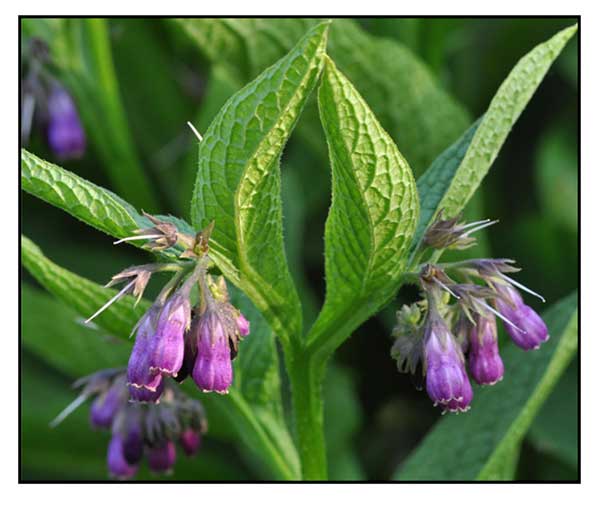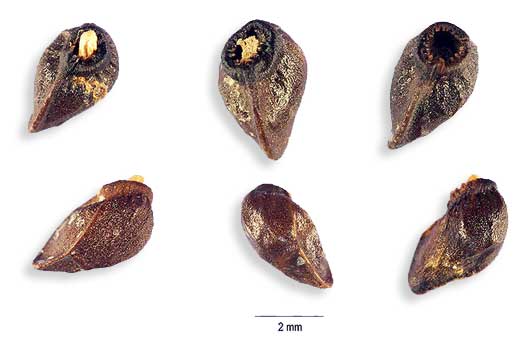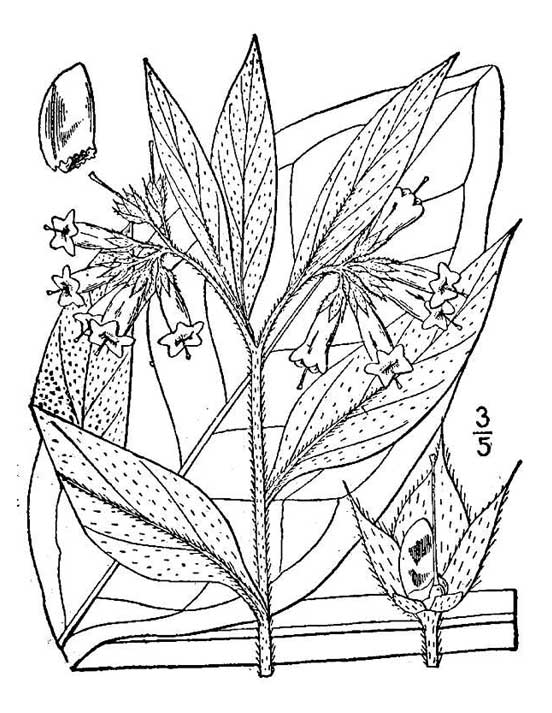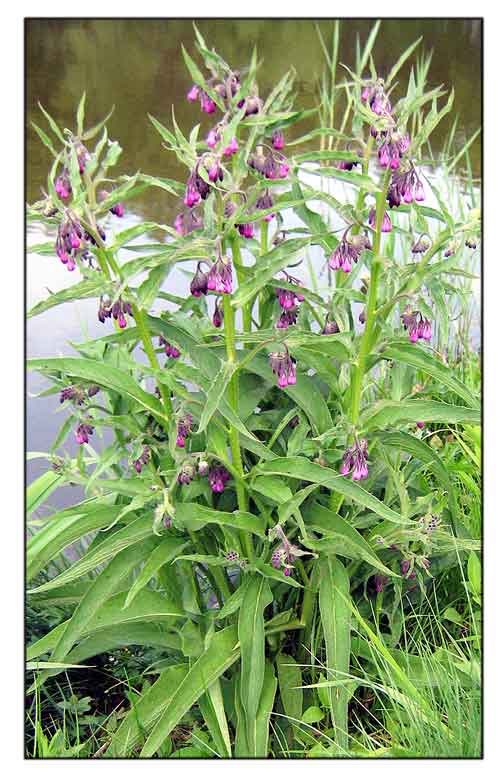|  General
info General
info
- Symphytum officinale is a perennial flowering plant in the family Boraginaceae.
-
An ancient herb
known since 400 B.C., used by the Greeks to treat bronchial problems,
wound healing and mending of broken bones. The name "Comfrey"
is a corruption of con firma,
the uniting of bones.
- Etymology: The common name comfrey is from the Latin word confervere, meaning to "heal" or literally to "boil together", referring to its use in ancient traditional medicine. (43) The genus name Symphytum derives from Greek words symphyo, meaning to grow together, and phyton, referring to the plants wound healing property.
-
The specific epithet officinale refers to its use for medicinal preparations. The first formal scientific description appeared in 1753 in Species Plantarum by Carl Linnaeus. (41)
-
Its early common names, knitbone or boneset, refers to its historical of poultices of leaves and roots to treat sprains, bruises, or bone fractures.
Botany
• Symphytum officinale is a hardy, leafy perennial.
Rhizomes are thick, black on the outside and white inside, containing a mucilaginous
juice. Leaves are entire, lanceolate to ovate-lanceolate, up to 10 inches
long, deep green and hairy. Flowers are variable in color, blue, yellow
or white, borne on short curved racemes, with five-lobed calyx and five
stamens. Fruits are nutlets.
 • Herbs forming tussocks, 30-90 cm tall, arcuate hispid, short strigose. Main roots purplish brown, stout. Stems erect or ascending, branched. Basal leaves long petiolate, lorate-lanceolate to ovate, 30-60 × 10-20 cm, apex acuminate; middle and upper stem leaves sessile, smaller, base decurrent. Inflorescences many flowered. Calyx parted nearly to base; lobes lanceolate, apex acuminate. Corolla light purple, purple-red, or yellowish white, 1.4-1.5 cm; throat appendages ca. 4 mm, not exserted beyond limb; lobes triangular, apex revolute. Filaments ca. 3 mm; lower part nearly as wide as anthers; anthers ca. 3.5 mm, apex with somewhat prominent connective. Ovary usually sterile, occasionally only 1 mericarp develops in a few flowers. Nutlets black, oblique ovoid or ovoid, 3-4 mm, smooth, shiny. (Flora of China) • Herbs forming tussocks, 30-90 cm tall, arcuate hispid, short strigose. Main roots purplish brown, stout. Stems erect or ascending, branched. Basal leaves long petiolate, lorate-lanceolate to ovate, 30-60 × 10-20 cm, apex acuminate; middle and upper stem leaves sessile, smaller, base decurrent. Inflorescences many flowered. Calyx parted nearly to base; lobes lanceolate, apex acuminate. Corolla light purple, purple-red, or yellowish white, 1.4-1.5 cm; throat appendages ca. 4 mm, not exserted beyond limb; lobes triangular, apex revolute. Filaments ca. 3 mm; lower part nearly as wide as anthers; anthers ca. 3.5 mm, apex with somewhat prominent connective. Ovary usually sterile, occasionally only 1 mericarp develops in a few flowers. Nutlets black, oblique ovoid or ovoid, 3-4 mm, smooth, shiny. (Flora of China)
Distribution
- Introduced in the Philippines
in the late 60s.
- Cultivated.
- Propagated by seed.
- Native to Altay, Austria, Belarus, Belgium, Bulgaria, Central European Russia, Czechoslovakia, East European Russia, France, Germany, Great Britain, Hungary, Italy, Kazakhstan, Krym, Netherlands, North Caucasus, Northwest European Russia, Poland, Romania, Sardegna, Sicilia, South European Russia, Spain, Switzerland, Turkey, Turkey-in-Europe, Ukraine, West Siberia, Yugoslavia. (9)
Toxicity Concerns and Safety Studies
• Hepatotoxicity: Since the late
70's, subject of persisting concerns and debate on certain alkaloid
contents that may cause liver damage, veno-occlusive liver disease,
ascites and hepatic fibrosis.
• Advice is given against use of comfrey as salad green or tea. (see study below: 34)
• In July 2001, the US FDA took steps to stop the marketing of
comfrey as a dietary supplement.
• Possibly safe
when used topically on unbroken skin in small amounts for less than 10 days.
• Use should be limited to 4 to
6 weeks per year at less than 100 mcg of unsaturated pyrrolizidine alkaloids.
However, with toxicity concerns, it is advisable to seek alternatives.
• Avoid oral use: Probably not safe
when taken orally. Potential for liver toxicity.
• Contraindicated in pregnancy and lactation.
• Interactions: Hepatotoxic drugs interacts with comfrey. Taking comfrey with drugs that might harm the liver can increase the risk of liver damage. Medications that increase breakdown of medications by the liver (cytochrome P450 3A4 (CYP3A4) inducers) interacts with comfrey.
(10)
 Constituents Constituents
• Considered antitussive,
expectorant, haemostatic, vulnerary, homepathy.
• Contains allantoin, between 0.6 to 0.8 % to which is attributed
its wound-healing properties.
• The healing constituent is allantoin. Ingredients may be steeped
or dissolved in hot water; boiling should be avoided as this may cause
the breakdown of allantoin.
• Phenolic acids: rosmarinic, chloogenic, caffeic and lithospermic
acids.
• Contains potentially hepatotoxic compounds: pyrrolizidine alkaloids,
including heliosupine, echimidine, heliosuipine, lycopsamine, symphytine
and cynoglossine. The alkaloid concentration is highest in small, young
leaves. Roots also contain high levels of these compounds.
• Study of hydroalcoholic extracts identified bioactive compounds viz., tannins, terpenoids,
sterols/triterpenoids, flavonoids, amino acids, reducing agents, flavones, saponins, and alkaloids. (11)
• Study of ethanolic and aqueous extracts yielded total phenolic contents of 116.93 mg GAE/g and 99.49 mg GAE/g, respectively. (see study below) (12)
• Study isolated three pyrrolizidine alkaloids from the roots viz., symlandine, symphytine, and echimidine. (20)
• Study of root extract yielded five compounds: rosmarinic, p-hydroxybenzoic, caffeic, chlorogenic and p-coumaric acid. (see study below) (24)
Properties
· Considered antitussive,
expectorant, haemostatic, vulnerary.
- The healing constituent is allantoin. Ingredients may be steeped
or dissolved in hot water; boiling should be avoided as this may cause
the breakdown of allantoin.
- Studies have suggested
antiproliferative, hepatotoxic, anti-inflammatory, antioxidant, mutagenic, antimitotic, proliferative, wound healing, antibacterial, anti-osteoarthritic, wound healing, antinociceptive properties.
Parts
utilized
Leaves , flowers
and roots.
 Uses Uses
Edibility
· Toxicity: See toxicity concerns on the use of comfrey as salad green or tea.
Folkloric
· In the Philippines, decoction of leaves used for treatment of hypertension. (36)
· Decoction of leaves used for a variety of illnesses: Asthma,
cough, ulcers, constipation, hypertension.
· Poultice of fresh leaves used for sprains and fractures, inflammatory
swelling, external wounds, sores, athlete's foot, burns, insect bites,
and abscesses.
· Used for excessive menstrual flow, cancer, angina, gums disease
· Juice of leaves used for a variety of skin ailments and wounds
healing; apply three times daily.
· Decoction of tea as a sleep-aid.
· Oil and ointment used to treat acne, boils, and psoriasis.
· Roots have been used for wound healing.
· Roots and leaves used for broken bones and wounds.
- Mashed roots are packed around a broken limb, drying to form a cast of "hardened plaster" of roots.
· In Ayurveda,
used for peptic ulcer.
· In Polish pharmacopoeia, as Radix symphyti, recommended as expectorant, especially
for children.
Others
· Compost: Because of high nitrogen content, leaves are often added to compost pile to help stimulate composting. Also used as fertilizer for young seedlings. (35)
Studies
• Antiproliferative: Study evaluated the effects of chronic oral treatment
of wistar rats with 10% comfrey ethanolic extract in a RHM (resistant
hepatocyte model). Comfrey treatment reduced the number of pre-neoplastic macroscopic lesions, percentage of oval cells and mitotic figures, and the number of re-neoplastic macroscopic lesions. Results showed the oral treatment of rats with 10% alcoholic extract reduced cell proliferation in the RHM model. (4)
· Mutagenic Effects: Mutagenic
effects of aqueous extracts of Symphytum officinale L. and of its alkaloidal
fractions – Aqueous solutions of three alkaloid fractions were
studied for antimitotic and mutagenic activity. Results showed mutagenic
activity to be induced by lasiocarpine, by alkaloidal fraction 1 and
by diluted infusions from Radix symphyti. Fraction III had only antimitotic
effect. (1)
• Herbal
Tea Concerns / Pyrrolizidine Alkaloids / Hepatotoxicity: Analysis
of herbal teas made from the leaves of comfrey (Symphytum officinale):
reduction of N-oxides results in order of magnitude increases in the
measurable concentration of pyrrolizidine alkaloids: The concentration
of symphytine and echimidine varied considerably in different tea leaves
preparation. Since alklaloids are known to be hepatotoxic, and because
the concentration of pyrrolizidine alkaloids may be underestimated,
consumption of comfrey herbal teas, in native or packaged forms, is
not advised. (8)
• Proliferative / Antimitotic: Results
indicate crude extract and its proteic fraction stimulate invivo proliferation
of studied neoplastic cells and and antimitotic effect on human T lymphocytes
in vitro stimulated with PHA. (6)
• Non-mutagenic:
Study of the comfrey root fluid extract contained in Kytta-Salbe
(R) f and Kutta Plasma (R) f was not mutagenic in bacterial reverse
mutation assay. (7)
• Safety
Assessment: Study highlighted significant differences in
the reported identification of pyrrolizidine alkaloids from the same
plant species, and demonstrates the inadequacy of some procedures to
include N-oxides in the assessment of pyrrolizidine alkaloid-related
safety of food and herbal products. (8)
• Antioxidant / Proliferative Effect: Study in Swiss albino mice evaluated the antioxidant and proliferative effects of aqueous and ethanolic extracts of Symphytum officinale. An ethanolic extract showed stronger radical scavenging activity against DPPH radical (IC50 39.97 µg/ml) compared with an aqueous extract (IC50 96.21 µg/ml). On cell proliferation assay evaluated on 3T3 Swiss albino mouse fibroblast cells by MTT and NRU assay, both extracts showed proliferative activity. (12)
• Liver Effects / Leaves: Study investigated the effect of aqueous extract of Symphytum officinale leaf on the liver of adult wistar rats. Doses of 0.4 ml, 0.6 ml, and 0.8 ml of aqueous extract were given orally for 28 days. Results showed consumption of Symphytum officinale in low dose or small amount had no effect on the histological appearance of the liver. However, high or excessive doses induced mild distortion of histological liver appearance, including mild central vein hypertrophy, increased cellularity and periportal fibrosis of liver cells. (13)
• Cytostatic Activity on HeLa Cells: Study investigated the cytostatic activity of total plant extracts of HeLa cells culture. Results suggest in vitro treatment of HeLa neoplastic cells with the concentrated extracts showed a mito-inhibitory effect with statistical and cytostatical significant amplitude. (15)
• Fracture Treatment: Report presents four cases of patients with bone fractures, treated with the aid of Homeopathic Remedy Symphytum officinale after proper alignment of the bone fragments. Although one case showed severely comminuted fracture and two showed poor compliance to immobilization, result of treatment was excellent, clinically and radiologically. Results suggest Symphytum can accelerate solid healing of the fractured bones. (16)
• Adverse Male Fertility Effects / Toxic Testicular Effects: Study evaluated the effect of aqueous extract of leaves of Symphytum officinale on male fertility in Wistar rats. Findings show increased dose of aqueous extract of leaves led to damage in testicular epithelium and adverse effect on sperm quality. Results showed toxic effects in testicular morphology of the rats. (17)
• Study on Carcinogenic Activity: Study evaluated the carcinogenicity of S. officinale in inbred ACI rats fed comfrey leaves for 480-600 days and comfrey roots for varying lengths of time. Hepatocellular adenomas were induced in all experimental groups. Hemangioendothelial sarcoma of the liver was infrequently induced. (18)
• Anti-Inflammatory / Roots: Study evaluated the anti-inflammatory effect of methanolic extract of roots of Symphytum officinale in an acute model of inflammation using egg white-induced edema in Wistar albino rats. Results showed oral administration of the extract significantly (p<0.05, p<0.01) inhibited raw egg albumin-induced rat paw edema. Maximum inhibitory effect was observed at 750 mg/kg. (19)
• Three Pyrrolizidine Alkaloids / Roots: Study isolated three pyrrolizidine alkaloids from the roots: symlandine, symphytine, and echimidine. (20)
• Ointment Treatment for Subacute Low Back Pain: Study evaluated the effect of a phytotherapic ointment of Symphytum officinale (PSO) on moderate physical exertion on sedentary subjects with subacute low back pain. PSO ointment treatment provided antalgic and emotional protection in treated subjects. Results suggest a potential for the PSO ointment as a form of pain therapy and antalgic protection in patients with low back pain during rest and under moderate exercise conditions. (21)
• Treatment of Pressure Ulcers: An open, prospective study evaluated 161 patients with 198 stage II or III decubitus ulcers with topical preparation of symphytum herb extract cream. Efficacy of symphytum herb extract treatment was surprisingly good. Over a treatment duration of 25-30 days, an 89.2% reduction of total decubitus area was observed, with 88% reduction of pressure ulcer depth. (22)
• Ointment for Treatment of Ankle Injuries: In a placebo-controlled clinical study, a statistically and clinically significant superiority of a comfrey extract versus placebo was demonstrated for the treatment of ankle distortions using tonometrically registered pain variables as target criteria. (23)
• Antioxidant / Proliferative / Roots: Study evaluated a root extract of S. officinale for antioxidant activity and effect on cell viability and proliferation of human skin fibroblast (HSF). HPLC-DAD analysis yielded five compounds: rosmarinic, p-hydroxybenzoic, caffeic, chlorogenic and p-coumaric acid. DPPH, FRAP, and TPC assays showed high antioxidant activity. MTT test showed a stimulatory effect on cell metabolism and viability of HSF cells. Results suggest a non-toxic root extract with strong antioxidant potential and a beneficial effect on human skin fibroblasts. (24)
• Wound Healing / Topical Formulation / Leaves: Study evaluated the wound healing activity of leaves extract incorporated in three topical pharmaceutical formulations (carbomer gel, glycero-alcoholic solution, and O/W emulsion) in an open wound rat model. The emulsion, commercial and prepared, induced the largest and furthest repair of damaged tissue. as evidenced by collagen deposition and reduction of cellular inflammatory infiltrate. An 8% prepared extract in emulsion showed best efficacy. The O/W emulsion was the vehicle most effective for wound healing. (25)
• Antibacterial / Leaves: Study evaluated the antibacterial activity of Symphytum officinale by Streak Plate method using various solvents against pathogenic bacteria viz., S. aureus, B. subtilis, P. aeruginosa, S. typhii, E. coli, and P. vulgaris. Both gram positive and gram negative bacterial strains were sensitive to the leaf extracts of all solvents except chloroform at higher concentration (75% and 100%). (26)
• Review / Anticancer / Anti-Osteoarthritic Pain: Review article screened 44 studies for anticancer and anti-osteoarthritic pain efficacy of S. officinale. Study reports that a plant ointment was effective in the treatment of osteoarthritis of the knee as evidenced by reduced pain, improved mobility and quality of life. On treatment of acute unilateral ankle sprain, S. officinale extract was likely superior to Diclofenac gel. Root extract cream was also superior to placebo in patients with acute upper or lower back pain. A novel phytochemical (p-DGA) from S. officinale was shown to suppress the growth and induce death in PCA cells. A study also showed that all S. officinale products contain remarkable amounts of pyrrolizidine alkaloids (PAs). Another study showed SO is mutagenic in liver, and PA from SO cause toxicity and tumor induction. (27)
• Mutagenicity in Rat Liver / Pyrrolizidine Alkaloids: Comfrey is a rat liver toxin and carcinogen and has been used as vegetable and herbal remedy by humans. Study evaluated the mutagenicity of comfrey in transgenic Big Blue rat model. Results showed comfrey is mutagenic in rat liver and the mutations induced by comfrey suggest its tumorigenicity results from genotoxicity of pyrrolizidine alkaloids in the plant. (28)
• Anti-Inflammatory / Effect on NF-kB Signaling / Roots: Study showed a hydroalcoholic extract of comfrey root impairs the development of pro-inflammatory scenario in primary human endothelial cells in a dose-dependent manner. The extract and mucilage-depleted fraction impaired the IL-1 induced expression of pro-inflammatory markers. Study showed comfrey inhibits NF-kappaB signaling at two stages. Results provide mechanistic insight in the mode of action of a century-old herbal medicine. (29)
• Anti-Inflammatory / Antinociceptive / Roots: Study evaluated the anti-inflammatory and antinociceptive activity of S. officinale root extract using carrageenan-induced paw edema method and acetic acid induced writhing in mice, respectively. Results showed significant and dose dependent reduction (55.6%) of carrageenan induced paw edema. In writhing test, thee SO extract inhibited by 45.25% the abdominal constrictions induced by acetic acid in mice. (30)
• Effect on Pain and Swelling of Ankle Sprains: A Randomized, multicenter, double-blind, placebo-controlled study evaluated the efficacy and safety of comfrey root extract in patients with ankle distortion. Ambulatory patients with unilateral acute ankle sprains received topical treatments with ointment of comfrey extract. The reduction in pain was significantly greater (p<0.05) in the comfrey group, with more rapid reduction in swelling, compared to the placebo group. Results were consistent with other clinical studies that have suggested comfrey extract is effective in alleviating pain and swelling associated with ankle distortions. (31)
• Blend of Comfrey Roots and Tannic Acid Creams / Osteoarthritis Treatment / Clinical Trial: Randomized, placebo-controlled, double-blind, multiclinical trials evaluated the effect of 2 concentrations of topical, comfrey-based botanical creams containing a blend of tannin acid and eucalyptus to a eucalyptus reference cream on pain, stiffness, and functioning in primary osteoarthritis of the knee. Results showed both active topical comfrey formulations were effective in relieving pain and stiffness and improving physical function and were superior to placebo without serious adverse effects. (32)
• Analysis of Herbal Teas / Pyrrolizidine Alkaloids and N-Oxide Forms / Toxicity Concern: Study evaluated the relative quantities of two hepatotoxic pyrrolizidine alkaloids, symphytine and echimidine, in teas prepared from comfrey leaves (Symphytum officinale) and to determine the potential contribution of N-oxide forms of these alkaloids to the levels of the parent alkaloids, i.e., the total quantities of alkaloids as free bases and as N-oxide derivatives. Results showed the concentration of symphytine and echimidine varies considerably between teas prepared from leaves purchased from different vendors. A higher concentration of symphytine were found in tea when steps were included to reduce N-oxides prior to analysis. Author suggests that since pyrrolizidine alkaloids are hepatotoxic, consumption of herbal teas made from comfrey leaves may be ill-advised. The concentration of alkaloids may be underestimated substantially. (34)
• Remediation Removal of Toxic Pyrrolizidine Alkaloids: The use of comfrey preparations has been shaded by the presence of PAs. These pyrrolizidine alkaloids have been scrutinized for toxicity through various invitro, animal, and clinical studies, revealing hepatotoxic, mutagenic, and carcinogenic effects. Acute of chronic ingestion of the PAs are absorbed in the gastrointestinal tract, followed by liver activation to pyrrole intermediates which translates into damage to hepatocyte membrane, hemorrhagic necrosis, veno-occlusive liver damage, finally into liver failure. Transdermal use followed by liver activation of PAs also restrict the use of topical comfrey on intact skin, at daily limit of 0.007 µg PAs/kg. Toxicological concerns have generated potential remediation approaches that may involve chemical elimination of PAs by selective removal from comfrey matrices by different (NA)DES-based combinations, removal from contaminated materials or genetic manipulation of plant chemistry to preclude synthesis of or reduce the level of PAs. (38)
• External Use of Comfrey: A survey reports of how herbal practitioners use comfrey externally in everyday practice. Of 239 herbalists who responded, 179 (75%) reported regular use of comfrey in 15% of their consultations, most commonly prescribed as a cream for tendon, ligament, and muscle problems, for fractures and wounds, where it was perceived most effective. It was least effective for hemorrhoids, varicose veins, and boils, and considered to carry greatest risk for ulcers, wounds, and boils. The practitioner experience survey suggest comfrey can be used safely and effectively externally for certain indications. (39)
• Detoxification of Comfrey Extract / Anti-Inflammatory, Antioxidant, Hepatoprotective: The medical use of comfrey is limited by its hepatotoxic effect of lycopsamine in comfrey, which overshadows the benefits of rosmarinic acid. Study evaluated a betaine-based and choline chloride-based NADES (natural deep eutectic solvents) for selective extraction of rosmarinic acid over lycopsamine. Betaine-urea (BU) was more effective in extracting rosmarinic acid, compared to methanol-UAE. BU extracts showed higher antioxidant and anti-inflammatory properties compared to other NADES extracts, with lower hepatotoxic profile. Results suggest the use of betaine-urea to detoxify comfrey for wider opportunities for medicinal use. (40)
• Effect on Acute Kidney Failure Model / Boiled Leaves: Study evaluated the effect of boiled comfrey leaf on serum creatinine and urea an gentamicin-induced acute kidney failure model in 30 male wistar rats. Results showed a decrease in serum creatinine and urea levels (p<0.05). (42)
Availability
- Wildcrafted
- Ointments, root and leaf extracts in the cybermarket.
|

![]()

